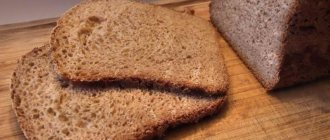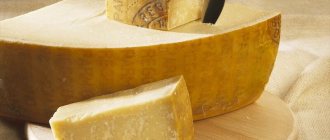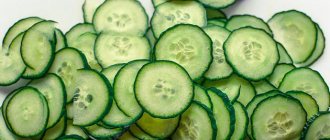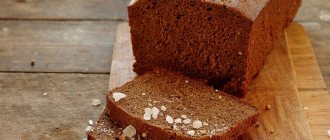Mozzarella is one of the most famous Italian cheeses with a pleasant taste. The product is a fresh buffalo milk cheese product with a juicy texture and appetizing aroma. Many Italian dishes cannot do without it, especially pizza, salads, appetizers, casseroles, lasagna and pasta. Not only culinary specialists, but also nutritionists and doctors have noticed the positive effect of this useful product on the human body. But, before including it in your diet, you will need to study additional information about this cheese, find out the beneficial properties and exclude contraindications.
History of the origin of mozzarella
The origins of mozzarella began during the Renaissance. The cheese was first mentioned in the cookbook of Bartolomeo Scappi, who was considered the best chef of those times. The book was published in 1570 and in it mozzarella appeared as a traditional product of those days, which makes it clear that cheese had an even older origin.
Historical documents already from the 12th century contained prerequisites for the production technology or use of mozzarella. Monks from the monastery of San Lorenzo in Capua treated pilgrims to cheese sandwiches called mozza.
Historians claim that in what is now Italy, mozzarella began to be made back in the 6th century, but from cow’s milk, due to the lack of buffalo populations in those areas. The animals initially took root in the marshy areas of Campania and Lazio, and it was then that the inhabitants of these cities came to the conclusion that dairy products made from buffalo milk were much tastier than meat. It was only in the late 18th century that mozzarella became famous due to the increase in the buffalo population.
According to some sources, cheese was invented completely by accident. The locals of Campania, having no refrigeration systems, left the milk in the cellar and forgot about it. After a while they remembered, but found there already soft cheese in the shape of a ball. Over time, the cheese became popular in other regions of Italy, and today Campania produces good quality mozzarella.
How to make mozzarella

Mozzarella is a soft, white, lightly salted steamed cheese with a pleasant, refined taste and flexible structure. It is covered with a thin crust with an appetizing glossy surface.
Make mozzarella as follows:
- Milk is heated to a temperature of 35 degrees, combined with a special bacterium, and in some cases a rennet element is added.
- Next, the resulting mass is sent for ripening, the time of which depends on the ambient temperature and the natural acidity of the raw material. On average, this takes 30 minutes in the warm season, and 60 in the cold season. An additional 20 minutes are also allocated for the milk mass to thicken.
- Break up the milk clot. The process is divided into 2 stages. Initially, a cross is drawn on the surface and left for 10 minutes, and then the mixture is mixed with a special metal nozzle to the very bottom.
- Small particles will then form and settle to the bottom. They will be ready when the acidity reaches 4.8-4.9 and the curd stretches well.
- The whey is drained. It turns out quite a lot and is usually used in the production of another equally popular Italian cheese - ricotta.
- The cheese curd itself is cut into small pieces using a special machine, and then poured with boiling water and a saturated salt solution.
The finished cheese is transferred to cold water, where it remains until it is sold.
Natural fresh mozzarella is sold in bags along with chilled liquid, a transparent white solution. The cheese can be in the form of a braid or large balls with a diameter of 7-10 cm. The range of consumers of such a product is not as high as that of delicate and soft cheese in brine.
Types of mozzarella

Manufacturers classify mozzarella into several types:
- fresh;
- fresh (from cow's milk);
- stretched (in the form of braids, knots);
- smoked.
Depending on the shape of the final product, mozzarella is divided into:
- bocconcini - egg-sized balls;
- chillenji - circles with large cherries;
- perlini - small pieces;
- Treccia - in the form of a braid.
Some manufacturers develop their own individual twisting method, which is their trademark, feature.
By shape
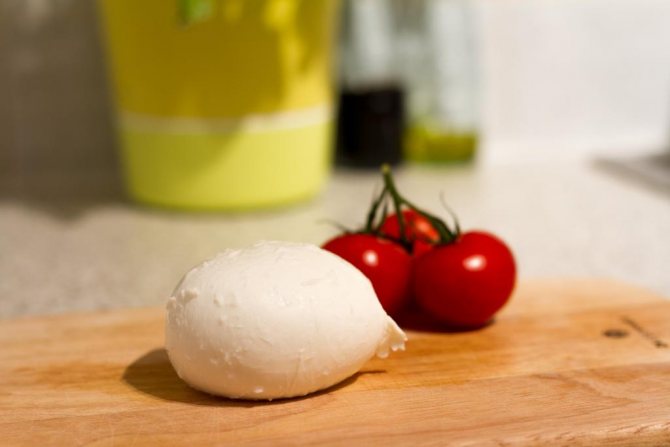
Classic mozzarella can be recognized by its irregular shape, which looks like a ball, and the size depends on the type of product:
- Perlini are small pearls.
- Ciliegini are medium in size, reminiscent of the shape of a large cherry.
- Bocconcini are the largest, about the size of an apple.
- Trecci is a braided product.
Mozzarella composition
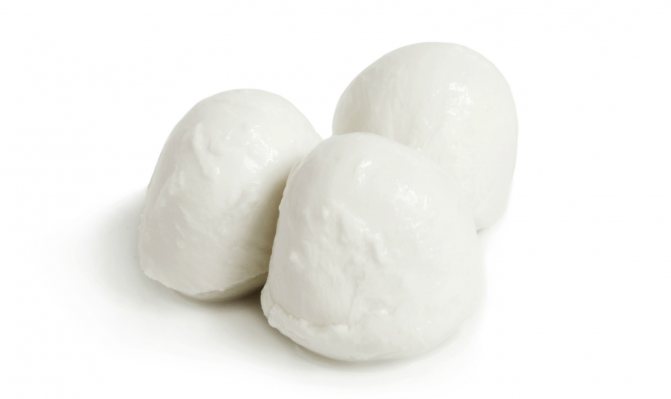
100 grams of mozzarella contain (bju):
- Proteins: 22.17 g;
- Fat: 22.14 g;
- Carbohydrates: 2.4 g;
- Water: 50.01 g;
- Ash: 3.28 g;
- Saturated fatty acids: 13.9 g;
- Monounsaturated fatty acids: 6.573 g;
- Polyunsaturated fatty acids: 0.765 g.
Vitamins:
- Vitamin A: 179 mcg;
- Retinol: 0.174 mg;
- Beta-carotene: 0.057 mg;
- Vitamin B1, thiamine: 0.03 mg;
- Vitamin B2, riboflavin: 0.283 mg;
- Vitamin B4, choline: 15.4 mg;
- Vitamin B5, pantothenic: 0.141 mg;
- Vitamin B6, pyridoxine: 0.037 mg;
- Vitamin B9, folate: 7 mcg;
- Vitamin B12, cobalamin: 2.28 mcg;
- Vitamin D, calciferol: 0.4 mcg;
- Vitamin D3, cholecalciferol: 0.4 mcg;
- Vitamin E, alpha tocopherol, TE: 0.19 mg;
- Vitamin K, phylloquinone: 2.3 mcg;
- Vitamin RR, NE: 0.104 mg.
Macronutrients:
- Potassium, K: 76 mg;
- Calcium, Ca: 505 mg;
- Magnesium, Mg: 20 mg;
- Sodium, Na: 486 mg;
- Sulfur, S: 221.7 mg;
- Phosphorus, P: 354 mg.
Microelements:
- Iron, Fe: 0.44 mg;
- Manganese, Mn: 0.03 mg;
- Copper, Cu: 11 µg;
- Selenium, Se: 17 µg;
- Zinc, Zn: 2.92 mg;
- Cholesterol: 79 mg.
The content of amino acids, polysaccharides and other organic substances expand the range of influence of the product on organ systems and normalize all life processes.
The huge content of calcium, phosphorus and vitamin A in the composition of mozzarella determines the value of this product for baby food, its importance in the menu of pregnant women, nursing mothers, and the elderly.
Mozzarella calories
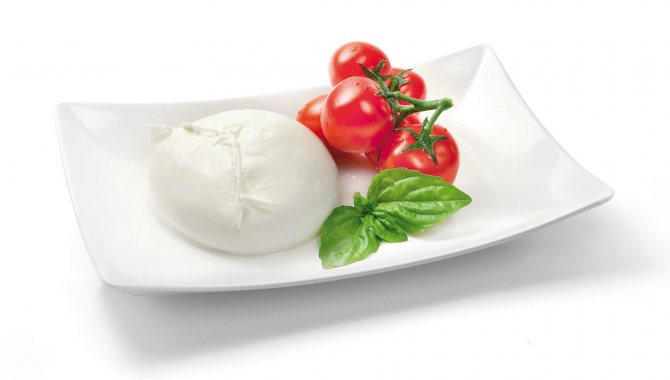
The calorie content of 100 g of mozzarella cheese is about 300 Kcal
, but the indicator may vary depending on the quality of the milk and the processing method. The natural product is a low-calorie cheese, therefore it is recommended by nutritionists to be included in the menu for weight loss.
The nutritional value of mozzarella is that more than 1/5 of the product is protein, which is quite important for people who want to lose weight. The increased fat content of the product should not be taken into account, as it is quickly absorbed by the body and has a positive effect on metabolism.
Mozzarella is included in fasting days and various effective diets. A natural source of protein and a balanced amount of valuable vitamins and minerals impress both nutritionists and people skeptical of any diet.
Composition and beneficial properties
Mozzarella is a source of protein necessary for muscle growth and strengthening. Regular consumption of the product helps prevent the crystallization of uric acid in the joints, which alleviates the symptoms of rheumatism.
Mozzarella is classified as a fresh type of cheese. According to the classic recipe, this product is prepared with buffalo milk. In the modern world, cow's milk of varying fat content is often used, which reduces the cost of the production process.
Useful substances included:
- some types of amino acids;
- vitamins B, K, D, E, retinol;
- polysaccharides;
- small amounts of Omega 3 and 6 fatty acids;
- phosphorus;
- magnesium;
- potassium;
- calcium;
- iodine, etc.
Be sure to read: Adyghe cheese: calorie content per 100 grams, composition, is it possible for weight loss, beneficial properties
The product also contains a significant amount of zinc, which promotes rapid protein synthesis and strengthens the immune system.
Important! Including mozzarella in the daily menu helps prevent metabolic syndrome, thereby ensuring the prevention of cardiovascular diseases.
Traumatologists recommend including this cheese in the diet during the treatment of fractures and various injuries, since retinol promotes rapid healing and tissue fusion.
The benefits of mozzarella

A detailed examination of the composition of mozzarella cheese revealed that the chemical compounds and mineral components found in it benefit the body:
- prevent vitamin deficiency by saturating the body with all the necessary biologically active substances;
- strengthen bone tissue, serve to prevent diseases of the musculoskeletal system;
- increase joint mobility;
- exclude atherosclerosis and many diseases of the heart and blood vessels;
- normalize the digestion process, prevent cancerous tumors of the intestinal tract;
- eliminate bad cholesterol;
- improve the condition of tooth enamel, hair, nails;
- provide the body with energy and endurance;
- increase performance, memory, thinking and attention;
- relieve insomnia and chronic fatigue;
- activate water balance, protect against dehydration;
- support women's health, eliminate inflammation and genitourinary infections;
- normalize metabolism, so that all calories consumed are consumed and not stored on the hips.
The natural product accelerates metabolic processes, which has a positive effect on a person’s well-being, his immunity, energy level, work potential, and positive attitude. Without it, it is impossible to imagine a complete and healthy menu that gives a person the necessary energy for life.
About the product
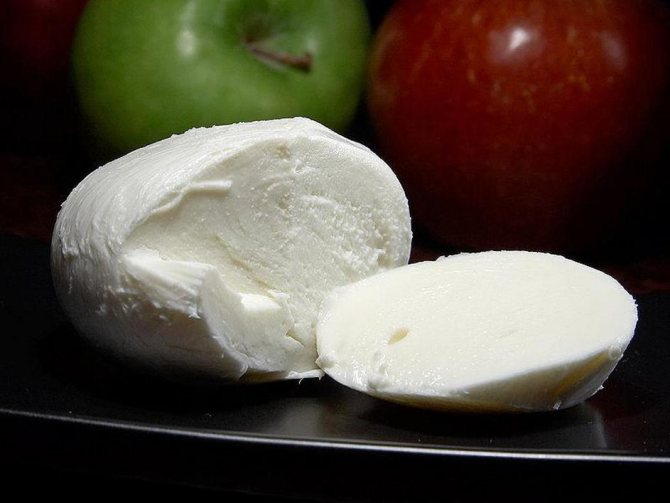
The region of Campania, located in southern Italy, is considered the birthplace of this product. The production technology in the Italian Republic has remained unchanged for several centuries, but the Russian composition of mozzarella cheese still differs from the traditional product. As a rule, in Italy, mozzarella cheese, the photo of which is presented above, is produced exclusively from buffalo milk. It differs from cow milk in its thickness, highest fat content, high calcium content and sweetish taste. As for the production of Italian cheese in Russia, in this case the use of both cow and goat milk is allowed.
Harm of mozzarella
Many people consider cheese to be an absolutely safe product, but there are a number of contraindications in which consuming mozzarella can cause harm to the body:
- Allergy or intolerance to milk protein.
- Kidney failure, swelling.
- Neurological disorders.
It is not recommended to eat cheese during an exacerbation of diseases of the digestive system: gastritis, pancreatitis, cholecystitis. But during the period of remission, it is useful to eat fresh cheese to diversify the menu and saturate the body with all the necessary substances.
Mozzarella does not contain a lot of salt and other spices, unlike other popular types of cheese. Therefore, the product is approved for hypertensive patients, people suffering from heart disease and digestive system disorders, as well as diabetes.
Mozzarella contains a lot of nutritious and healthy fats, which in small quantities stimulate metabolism and promote weight loss.
Excessive intake of the product can provoke obesity, so nutritionists advise lovers of this type of cheese to switch to a low-fat version.
Improper storage or expired mozzarella can be harmful to the body.
Benefits and harms
One large ball of cheese contains more than 150 mg of calcium, which is good for skin, hair, nails and bones. If you eat mozzarella regularly, it contains vitamins
The condition of the nervous system improves, and insomnia stops.
If you follow a diet that includes this product, you can get the following benefits for the body:
- strengthening blood vessels;
- restoration of weakened vision;
- normalization of blood pressure;
- PMS relief;
- strengthening bone tissue;
- reduction of headaches;
- blood thinning.
Potassium, which is part of cheese, helps restore the cardiovascular system, saturating the heart muscle and strengthening it.
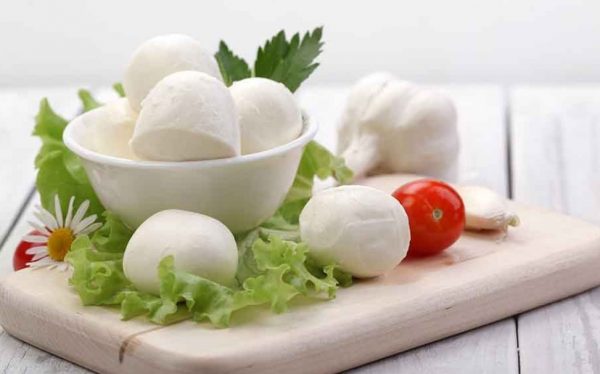
Potassium, which is part of cheese, helps restore the cardiovascular system
Despite all the positive qualities of cheese and its benefits for the body, there are cases in which this product can be harmful to health.
Main contraindications to eating mozzarella:
- cow protein intolerance;
- renal failure;
- neurological pathologies;
- lactose intolerance.
If consumed in excess, the following side effects may occur:
- disturbances in the functioning of the central nervous system;
- the appearance of gluten intolerance;
- kidney disease;
- complications of stomach ulcers.
Many manufacturers add large amounts of salt to cheese to give it a stronger flavor. When following a diet, it is important to consider the content of this spice in the product.
Important! It is necessary to monitor the expiration date and safety of the cheese after opening the package. It is easy to notice that the product is spoiled: a yellow crust appears on the mozzarella ball, the brine becomes cloudy, and traces of mold are visible.
Mozzarella in cooking
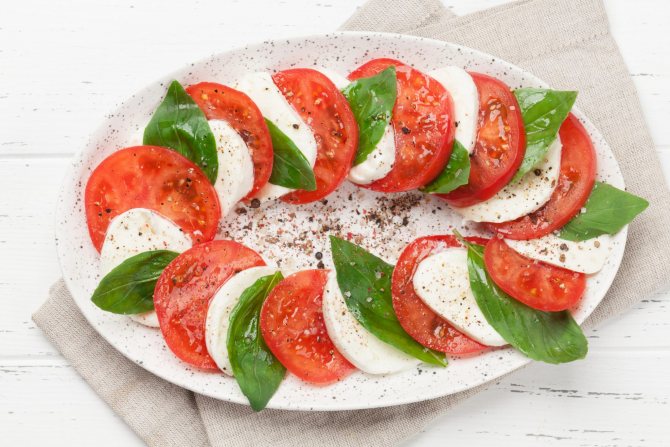
The taste characteristics of mozzarella have made the product popular in cooking. It is used in the preparation of many dishes, especially Italian cuisine. Most of the signature classic dishes of the restaurant world are not complete without this delicate and aromatic cheese.
Culinary experts recommend using mozzarella for:
- cold snacks;
- fresh salads of vegetables and herbs with olives;
- caprese appetizer salad;
- traditional Italian pizza;
- classic closed calzone pizza;
- lasagna, casseroles;
- many vegetable, mushroom and meat dishes;
- food in pots;
- various desserts.
Mozzarella goes well with tomatoes, basil, pepper, and is decorated with herbs, olives, and aromatic spices. It is usually served with white wine PinoGrigio or PinoBianco.
When preparing dishes, it is important to take into account that prolonged heat treatment at high temperatures will dry out the cheese, which will significantly worsen the taste.
Recipe without rennet
Homemade mozzarella, the recipe for which requires a minimum amount of ingredients, turns out to be as tasty as classic cheese.
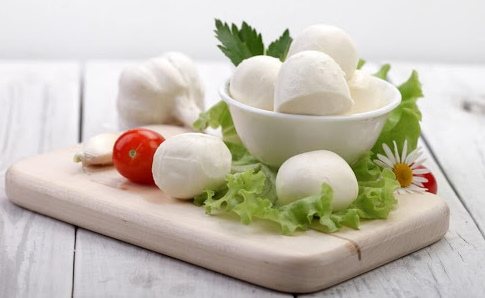
Composition of ingredients
For a recipe without rennet, you will need the following amount of products:
- 5 liters of milk;
- 0.4 l of sourdough;
- 1.5 tbsp. l. salt.
Step-by-step cooking process
- Pour the milk into a deep saucepan and put it on the stove. You need to bring it to a temperature of 30 degrees. In this case, the contents of the container must be stirred periodically with a spoon. In this state, you need to maintain the specified temperature for 40-45 minutes.
- Then the milk and starter should be left for 1 day at room temperature.
- After the time has passed, it’s time to cut the curd into a cube of approximately 5x5 cm.
- The mass needs to be heated to a temperature of 32 degrees in about 75 minutes.
- Then again slowly (1.5 hours) you need to heat the mixture to 40 degrees, stirring it gently.
- It's time to pour the cheese mass into a large bowl lined with a cloth or several layers of gauze. Then you need to lift the fabric by the edges and form a lump of cheese, sending it under the press in a fabric bag.
- The weight of the press should be gradually (every 15 minutes) increased, you need to start with 8 kg, end with a weight of 32 kg. The cheese must be kept under maximum load for at least 60 minutes.
- Next, the mixture must be removed from the press, the head of cheese cut into cubes and sprinkled with salt, mix thoroughly. The mass must again be left under pressure in a fabric bag in the same way.
- It is recommended to dry the finished cheese in the refrigerator until it becomes dry. After this, you need to cover it with a lid to avoid drying out.
- Mozzarella can be refrigerated for up to 3 weeks.
What can I add?
Instead of sourdough, you can use sour cream, kefir or yogurt in the recipe.
How to serve a dish
Homemade cheese can be eaten for breakfast, lunch or dinner. The product is an ideal component for vegetable and herb salads. The most common salad with this component is the well-known Caprese. You can take cheese sandwiches with you on a walk or to work as a snack.
How to replace mozzarella

Due to the extraordinary juiciness, delicate taste and aroma of mozzarella, it is difficult to find a similar product with similar parameters. But not every person can afford such a product due to allergies or lack of availability.
Experienced chefs know that mozzarella can be replaced with other equally nutritious products, including:
- feta cheese;
- Suluguni;
- Tilsiter;
- Adyghe cheese;
- feta;
- ricotta.
When choosing a suitable replacement, you should focus on the dish and its taste characteristics. For example, in Caprese salad you can get by with feta cheese, and grease lasagna with feta cheese. Any cheese product is suitable for baking, even Parmesan or Russian cheese.
Finding fresh mozzarella these days is not an easy task. Quite often, products in supermarkets turn out to be far from the original cheese, rich in casein. The reason is incorrect production and storage technology, since real cheese is fresh only for the first day, as well as the use of cow's milk instead of black buffalo milk.
What you need to know about Mozzarella cheese
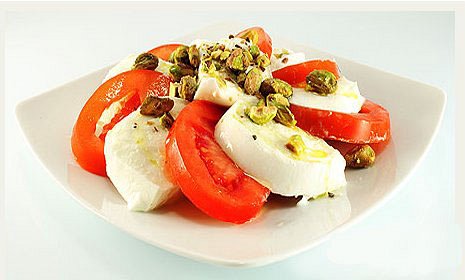
In the first case, the cheese is intended for fresh consumption - mozzarella is added to salads, combined with fruits and vegetables, and eaten simply as a delicacy with sweet tea. But the same cheese, but in vacuum packaging without brine, is intended for making pizza - it will even be labeled “pizza cheese.” Mozzarella cheese in brine should not be subjected to heat treatment: when heated, it will turn into cottage cheese and water, and when frozen, it will simply crumble. That is why storage of Mozzarella is not provided - cheese must be purchased in quantities that are immediately consumed.
Is it possible to freeze mozzarella?
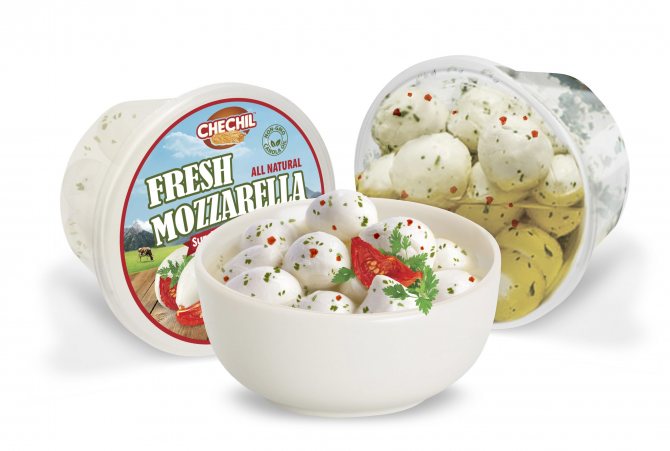
Manufacturers categorically do not recommend freezing mozzarella, since after exposure to low temperatures it will turn into a shapeless curd mass and completely lose its taste. But if a more gentle freezing method is used, a different outcome is possible.
It consists of the following steps:
- Be sure to remove the cheese from its original packaging.
- Place in a special glass container designed for freezing.
- Fill the container with brine from the manufacturer's packaging so that the mozzarella is completely immersed in the liquid. It is worth remembering that when frozen, moisture expands, so there should be free space in the container.
- Seal the container hermetically and place in the freezer.
Under such conditions, the shelf life of mozzarella is extended to 1 month. Defrost the product only in the refrigerator. If you place it immediately in a warm room, there is a high probability of the cheese spoiling. It is worth considering that this freezing system works with a natural and high-quality product, which, unfortunately, is now quite difficult to find in stores. To ensure a longer shelf life, mozzarella is filled with various preservatives and other substances that are harmful to the body and spoil the overall taste of the cheese.
Mozzarella is an appetizing, tender and juicy cheese that does not leave any gourmet indifferent and is a signature ingredient in many dishes. Using a natural product, you can experiment in the kitchen, realizing the most unusual ideas for appetizers, salads, pastas, pizzas and even desserts. The main thing is to study the information about mozzarella in detail and, armed with knowledge, adjust your own nutrition menu, supplementing it with healthy cheese.
Choosing and storing cheese
The name of the product variety depends on the size of the balls:
- bocconcini - one large ball with a diameter of approximately 5 cm;
- chiliegini - several medium balls with a diameter of 1.5-2 cm;
- perlini - small balls with a diameter of 0.5-1 cm.
The brine in which the cheese is stored is cloudy white. Thanks to this solution, the product does not dry out for a long time. The shelf life of natural mozzarella does not exceed 30 days, and for the products of some manufacturers it is even shorter.
Once the package is opened, the cheese must be consumed as soon as possible, as it cannot be stored in air.

